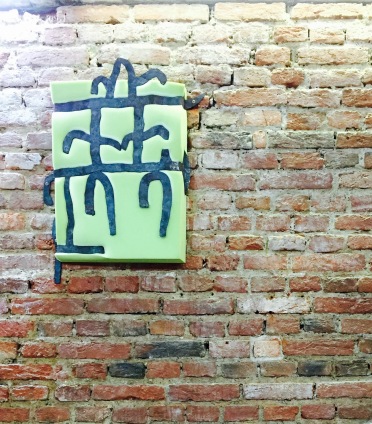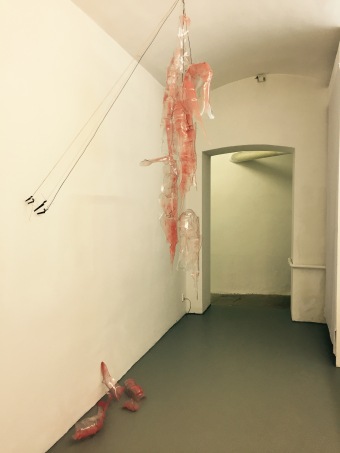06. 08. 2015- 18. 10. 2015
Contemporary Calgary- Steven Avenue Location
Exhibiting Artists: John Boyle-Singfield, Tammi Campbell, Liza Eurich, Louise Lawler, Jennifer Marman & Daniel Borins, John Marriott, Ken Nicol, Jon Sasaki, John Wood & Paul Harrison
Curator: John G. Hampton
Minimalism wasn’t a real idea- it ended before it started. – Sol LeWitt

Why Can’t Minimal, the current exhibition on show in Contemporary Calgary’s Stephen Avenue location, seeks to expose and engage the humorous side of minimal art. By uncovering the latent absurdity lurking beneath its cold exterior, this particular collection of works invites the viewer to adapt an intuitive response to a style that has traditionally been dominated by formal concerns. Utilizing the potential of CC’s multi-level facility, the selected art works interact and play off one another in a delightfully dynamic way. Curator John G. Hampton’s ambition was to create a show that “rejects the assumption that minimal art requires solely serious, solemn contemplation, and embrace the personal pleasure that occurs when one has fun with the comically utopian ambitions of unitary forms.” Conceptual value aside, these works alternatively suggest recognition through a playful and individually engaged response- free from the burden or attaining rational comprehension.
As Hampton acknowledges early on in his accompanying text, the show is not intended to make you laugh out loud and getting in on some inside joke is not the point either. These works seek to acknowledge and overcome the aspects of minimalism that can be intimidating. As the aforementioned quote by LeWitt indicates- even the early minimalists didn’t necessarily anticipate the deliberate response that their work received. A lot of the congestion surrounding minimalism can be blamed on the literature that has arisen as a result of it. It is rather ironic that a movement known as minimalism, a style characterized by extreme restraint in the use of colour and form, and the employment of simple geometrical, often repetitive, motifs, has inspired some of the most notably convoluted commentary of contemporary criticism. Amidst the muddle, it can be difficult to pinpoint the real impetus behind these works and far easier to fall victim to intellectual entrapment.
Not that pinpointing anything is necessarily the point, nor is exposing any inherent flaw with the ideology of minimalism, as it were. Therefore, it was important to Hampton that the works selected employed humour rather than irony towards the subject of their inquiry. Several of the works contain direct references to their predecessors, yet the spirit they evoke is one of good-natured solidarity rather than high-caliber critique. Despite the fact that much could be said of John Boyle-Singfield’s revised choice of liquid for his adaptation of Hans Haacke’s prorto-minimalist Condensation Cube, Untitled (Coke Zero), Hampton suggests, “a light-hearted viewer may simply appreciate the novelty of its absurdist form without searching for any articulable thesis.”
That being said, this exhibition might claim to be light-hearted, but many of the works contain references that extend beyond a recognition of levity and sentiment. Addressing other suspicions of the short-comings of minimalist philosophy, Hampton includes works that directly confront accusations of the “theatricality” of its physical nature and the problem of a conspicuous masculinity at work in minimalist philosophy.

(John Boyle-Singfield, Untitled (Coke Zero), 2012)
The accusation that minimalism transformed the viewing into a type of spectacle (put forth most notably by Michael Fried), is addressed directly in the comic performance Six Boxes, where John Wood and Paul Harrison enact the physical viewing drama in all of its glory. The pleasure one receives through watching a mechanical body interacting with human-scale forms through complementary spatial relationships is not gratuitous, as the familiarity of the event is genuine.
In regard to addressing a feminine response to minimalism, Hampton includes important works by four women artists. In particular, Louise Lawler’s Birdcalls (1972) serves as an ideal means by which to bridge the gap between the mostly male minimalists of the 1970s and their contemporaries. A six minute roll call that underscores problems of gender and privilege in the art economy- the work (the artist’s only audio piece) consists of Lawler playfully mocking the privilege of male artists – including many of her contemporaries, such as Vito Acconci, Dan Graham, Ed Ruscha, and Lawrence Weiner – by transforming their names into birdcalls. Yet the work, in its explicit irony and eschewal of the visual, represents not only a turning point in 1970s feminist art production, but a critical model that resonates with contemporary production and curatorial practice that don’t adhere to the notion of a fixed site.
Lawler’s piece plays on the ability of sound to occupy many spaces, sometimes simultaneously, including the gallery, cassette tape, the image, the printed word, and cultural spheres of linguistics, gender, economics, and politics. The fact that the nature of a soundpiece overcomes the conventional boundaries of the gallery speaks to the larger vision of the exhibition, which seems to aim at overcoming the “ideology” of the gallery as well.

(Louise Lawler, Birdcalls, 1972)
Whether explicitly re-shaping the structural dynamics inside the gallery, or introducing a new perspective on the role of humour and play within the gallery, each of these works somehow challenges traditional notions of presence before, and relationship to, a work of art. That being said, in considering these works, it is necessary to evaluate their impact from a relative perspective, being careful to address how effective they can actually be with the current gap that exists between art creation and reception. Is it too much to expect the viewer to find humour in the revealing of the innate quality of the materials used? Does this exhibition, in fact, remind us that reality does not conform to the rules of etiquette?
Yet, as the works themselves suggest, perhaps the preoccupation with these questions is itself the problem. In his introductory text, Hampton sites Deleuze and Guattari in stating that the practice of art is to “raise the absurd to the highest level of thought.” Typical of their idiom, this is an ambiguous statement, and yet their larger philosophical approach to art, that it is “beyond signification” is exactly what this exhibition is about. Minimalism, and the turn it represents, is away from straightforward signifying strategies and away from a certain kind of politics of art might be characterized as a turn (back) to the aesthetic potential of art.
This is not necessarily to reinstate a transcendent space for art, to position it in an ‘elsewhere’ or to suggest that it transports us to an ‘elsewhere’, but it is to say that art is more than just an object to be read. There is also something that remains, “an excess” (to use Deleuzian terms) that is ultimately “irreducible to signification.”

(John Wood and Paul Harrison, Six Boxes, 1997)
Then again – we need not overcomplicate matters- it is important to acknowledge that there has always been a humanizing aspect to the practice of minimalist art, as it sought to reduce the complexities of various crafts and bring them back to the people. As the curator suggests, if the show has made you smile, laugh, or you’ve simply found it “pretty”, then that is enough. This unexpected injection of light-heartedness into the gallery can almost be unsettling at first, but quickly reminds us not to take ourselves (or art) too seriously.
We are prompted to maintain an organic approach to experiencing and interpreting art in dialogue with the society we live our daily lives in. Maybe it’s not so much that minimalism was over before it started, but rather, that it is more relevant than ever. In a world that seems to have lost sight of the art of subtlety and the practice of restraint, perhaps understated works that quietly provoke humour are exactly what we need in the gallery. The white cube doesn’t need to be a place of alienation and Why Can’t Minimal questions why we create a schism between the natural and the constructed, in a way suggesting that we become more broadly responsible for our own relationship to art. In a sense these works remind us that it is only a matter of choice to see them as burdened by the weight of cognitive labour- perhaps the virtue they really emit is an acknowledgement of the levity of human fallibility. Resisting the ideologically saturated environment of the gallery space, this show is presented with fewer distractions that interfere with the purely attractive and engaging aspects of minimal art, allowing the works to open themselves to a larger range of interpretation- as defined uniquely by each individual.
51.048615
-114.070846


































